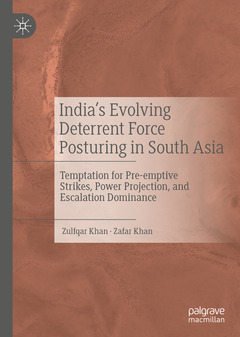India’s Evolving Deterrent Force Posturing in South Asia, 1st ed. 2021 Temptation for Pre-emptive Strikes, Power Projection, and Escalation Dominance
Auteurs : Khan Zulfqar, Khan Zafar

The book discusses India?s evolving deterrent force posturing in South Asia under the conceptual essentials of nuclear revolution when it comes to various combinations of conventional and nuclear forces development and the strategic implications it intentionally or unintentionally poses for the South Asian region. The book talks about how the contemporary restructuring of India?s deterrent force posture affects India?s nuclear strategy, in general, and how this in turn could affect the policies of its adversaries: China and Pakistan, in particular.
Authors discuss the motivations of such posturing that broadly covers India?s restructuring of its Nuclear Draft Doctrine (DND), the ballistic missile development program, including that of its Ballistic Missile Defence (BMD) system, and the possibility of conflicts between China-India and India-Pakistan, given their transforming strategic force postures and their recurring adversarial behavior against each other in the Southern Asian region.
Zulfqar Khan serves as a Professor, Head of Department at the Department of Strategic Studies, National Defence University, Islamabad, Pakistan. Professor Khan has wide experience as a research analyst in the Pakistan Ministry of Defence (MoD), several policy think tanks in Pakistan, and more recently National Defence University, Islamabad. He has contributed more than 45 research articles (both leading national and international journals), and a number of policy papers in this regard including his book on Nuclear Pakistan: Strategic Dimensions (2011).
Zafar Khan is currently an Assistant Professor with the Department of International Relations, University of Balochistan, Quetta. He has also taught at the Department of Strategic Studies, National Defence University, Islamabad, Pakistan. His papers have appeared in various international peer-reviewed journals. He has authored Pakistan’s Nuclear Policy: A Minimum Credible Deterrence (2015) and Nuclear Deterrence in South Asia: New Technologies and Challenges to Sustainable Peace (2020).
Explores the evolving prospects of Indian deterrent force posture in South Asia
Covers India’s restructuring of its Nuclear Draft Doctrine (DND), the ballistic missile development program
Attempts to relate the applicability of theory of nuclear revolution in South Asia and the lessons the South Asian nuclear rivals may learn
Asks how India’s evolving deterrent force posture is perceived in Pakistan
Date de parution : 12-2020
Ouvrage de 381 p.
14.8x21 cm



